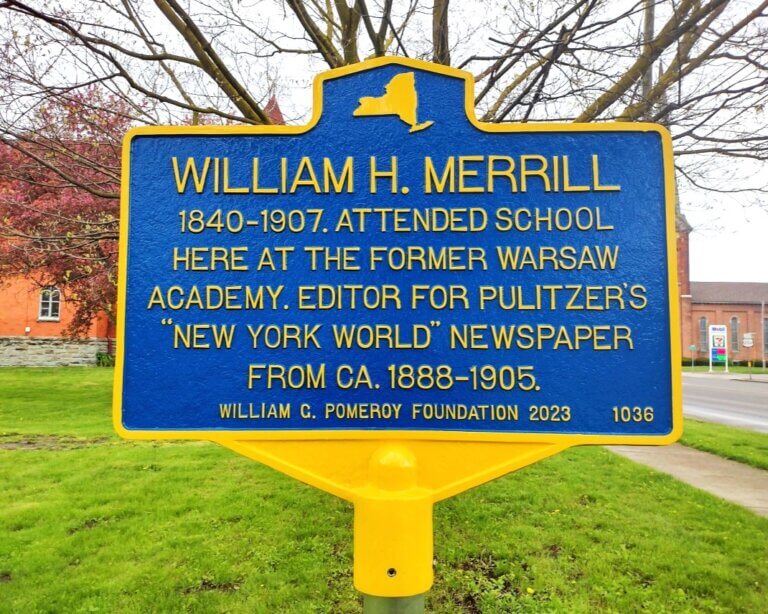WILLIAM H. MERRILL
- Program
- Subject
- Location
- Lat/Long
- Grant Recipient
-
NYS Historic
-
Education, People
- Warsaw Big M, Warsaw, NY 14569, USA
- 42.738762011459, -78.132795005533
-
Town of Warsaw
WILLIAM H. MERRILL
Inscription
WILLIAM H. MERRILL1840-1907. ATTENDED SCHOOL
HERE AT THE FORMER WARSAW
ACADEMY. EDITOR FOR PULITZER’S
"NEW YORK WORLD" NEWSPAPER
FROM CA. 1888-1905.
WILLIAM G. POMEROY FOUNDATION 2023
Beginning in 1846, the Warsaw Academy served as a staple of the Warsaw community until it closed to students in 1873. From there, it passed hands until it was purchased by the Warsaw Masonic Lodge, who maintains ownership as of 2023. The school is also featured on the National Register of Historic Places.
Undoubtedly, the school left an important imprint on the Warsaw students who received an education there—one such notable pupil, William H. Merrill, remained closely linked to the building, even after graduating and moving on to national acclaim as an important newspaper editor.
In 1903, during the centennial celebration of Warsaw, Merrill delivered a speech on the history of education in the community, which was later published as the History of the Warsaw Centennial Celebration that same year. His address starts on page 81 of that publication, and in it, he recalled watching the construction of the Warsaw Academy as a young boy, during which the older students were paid the price of a circus ticket to gather stone from a nearby quarry. These stones were then used in the construction of the cobblestone building. He mentioned teachers—some good, some taskmasters and some unprepared to deal with the rigors of the classroom—who he remembered from his time at the school. His connection to the academy didn’t end there though. He also recounted his time on the schoolboard for the Warsaw Academy. In fact, he was on the board when it was decided the Academy had been outgrown, and that a new school was needed to serve the students of Warsaw.
So, from its circus-ticket-for-stones beginning, all the way to the end, you might say Merrill was tied to the Warsaw Academy.
Merrill’s reminisces were laced with humor and demonstrated an impressive ability to keep an audience engaged, which, given his line of work, comes as no surprise. As an editor for the New York World, Merrill’s pen shaped the perceptions of countless readers, and it played an important role in the newspaper rivalry between Joseph Pulitzer’s World and William Randolph Hearst’s New York Journal.
Notably, and evidence of his importance to the World, Merrill was a speaker at the unveiling of the 1890 Pulitzer Building in New York City and was also featured in the 1903-1905 publication of “Who’s Who” in America. Merrill worked nearly fifteen years for the World, before leaving for Boston, where he worked as an editor at the Boston Herald shortly before passing away unexpectedly in 1907.

